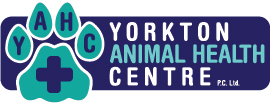Library
-
Depending on the size and breed of the dog, heats (estrus) can begin as early as four months old and can occur as frequently as every four months. Spaying a dog either through ovariohysterectomy or ovariectomy is the most effective way to prevent pregnancy. Spaying also negates false pregnancies and pyometra and reduces the risk of mammary cancer. Drugs that regulate the heat cycle are not approved for use in the US or Canada.
-
Bismuth compounds are given by mouth and are used on and off label to treat diarrhea and upset stomach. Give as directed by your veterinarian. The most common side effects include discolored stools and constipation. Do not use in pets that are allergic to it or other NSAIDs, or in pets that have a stomach or intestinal ulcer. If a negative reaction occurs, please call your veterinary office.
-
Bites wounds are one of the most common reasons dogs are seen for emergency appointments with their veterinarians. The dog's teeth and jaws are very powerful and the wounds they inflict can crush or tear muscles and skin, penetrate through the chest wall and cause lung collapse, or cause serious or fatal damage to intestinal organs. All bite wounds are considered to be contaminated and/or infected. Left untreated, the bacteria in an infected bite wound will cause a localized abscess or more generalized cellulitis that spreads through the surrounding area. All bite wounds should be treated by a veterinarian as soon as possible. Treatment will depend on the extent of the injuries, your dog's general health, and the location of the wounds.
-
Green and black tea is given by mouth, over the counter, and is used off label to treat cancers and inflammation. Give as directed by your veterinarian. The most common side effects of caffeinated green/black tea include nervousness, sleeplessness, increased heart rate, and anxiety. Based on human studies, green and black tea should be used cautiously in pets that have kidney disease, stomach or intestinal ulcers, heart disease, insomnia, glaucoma, or high blood pressure. If a negative reaction occurs, please call your veterinary office.
-
The Black and Tan Coonhound loves to sniff up a trail and go on a hunt, but he's also a mellow fellow content to lounge around the house — as long as he gets out for a good walk or jog every day.
-
The Black Russian Terrier is a courageous and confident dog who tends to be aloof with strangers but utterly devoted to his people. To reach his full potential, he needs consistent guidance and direction from his equally confident owner.
-
Bladder stones (uroliths or cystic calculi) are rock-like formations of minerals that develop in the urinary bladder. There may be a large, single stone or a collection of stones that range in size from sand-like grains to gravel. It is common for a mixture of both small and large stones to be present.
-
Dogs appear to be more susceptible to blastomycosis than many other species. The blastomycosis fungus seems to target the respiratory tract, although it may spread throughout the entire body. Cytology and/or histopathology are required to diagnose blastomycosis conclusively. Itraconazole is the preferred drug of treatment for most dogs. Prognosis is good for many cases of blastomycosis infection with recovery rates between 50-75%.
-
Blepharitis means inflammation of the eyelid and can affect one or both eyes. The affected eyelid will usually be red, swollen, and itchy. Any condition that can cause irritation of the eyelids can lead to blepharitis. Common causes of blepharitis include congenital abnormalities, allergies, infections, tumors, and occasionally other inflammatory disorders. Your veterinarian will conduct an eye examination to determine the extent of the eyelid involvement. Specific treatment for blepharitis will depend on the underlying cause of the disorder and the prognosis depends on the cause.
-
Gastric Dilatation and Volvulus (GDV) is an acute, life-threatening condition where the stomach fills with large amounts of air and then twists around, effectively cutting off the outputs to the esophagus and intestine. Causes, signs, treatment, prognosis, and prevention are discussed.


